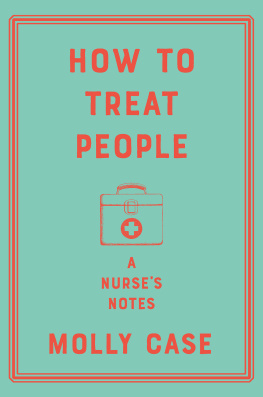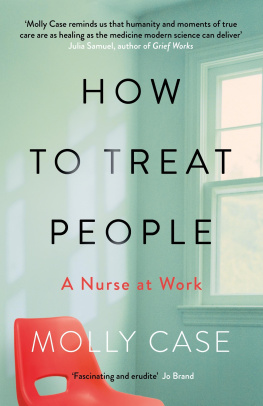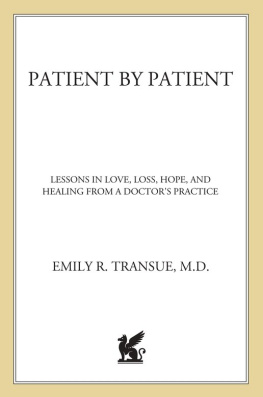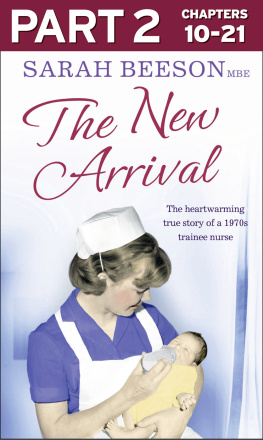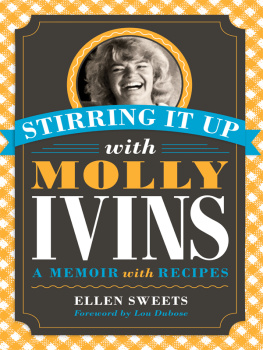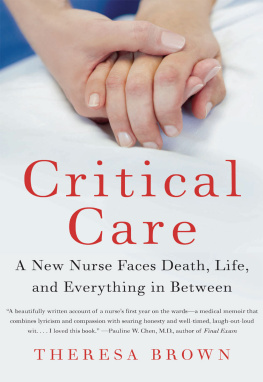
Contents
How to Treat People
A Nurses Notes
MOLLY CASE

W.W. NORTON & COMPANY
Independent Publishers Since 1923
To my family
Acknowledgements
Thank you to my family for allowing me to write about our lives. I owe everything Ive learnt and pursued so far to the knowledge youve imparted along the way and the experiences that youve given me.
Thank you to my mum for her wisdom and her time spent reading early versions, helping me to edit; thank you to my sister for her insight and expert mother and baby knowledge; to my dad who I know feels bemused that a whole book could be written about him, of course it could, he is the most fascinating person we know; and to Rob whose patience, love and understanding of both me and the story I wanted to tell, has helped me finish this book.
Thank you: Zo Waldie who inspired me from the moment I met her and has guided me ever since, Mary Mount who transformed the book into what it always should have been, to Dr Steele, Dr Glizevskaja, and Dr Dhillon who enlightened me with their cardiac knowledge, to the surgeons that operated on my dad, my nursing colleagues who I have learnt so much from, many of them nursing Dad back to health, and who in those days at the hospital let me simply be a daughter. And thank you to the patients, for giving me this incredible career and letting me be part of their own stories.
The year I left for university, we received a call on the home phone late one evening. Mum picked up. It was my auntie. Her voice was high-pitched and frantic, scrabbling to piece her sentences together like dropped change on the pavement. I listened in. She said that my grandmothers neighbours had been trying to get into her house over in Richmond. They could hear her dachshund barking; he was jumping up and scratching at the window in the living room. I thought of that window, which Id sat beside over so many years; it stretched from one side of the room to the other, looking out onto the garden. In the garden was the magnolia tree. The flowers were perfectly pink, the petals translucent, lying softly in the grass like shells left behind by the tug of the tide.
After the phone call, the neighbours managed to get inside. They rang us back half an hour later. They had found my grandmother sitting in her armchair, head slumped, the dog nuzzling her feet. She had died.
We drove to her house. Richmond Park was dark. A solitary bicycle light strobed across the grass, catching the retina of a stag, motionless, an unwavering silhouette in the glare.
At the house, Mum asked whether I wanted to see Granny, or would it upset me too much? I told her I wanted to see her and say goodbye. The police were already there. I stood with them in the small kitchen my grandfather had built, whilst my mum went in to see her mother. I stared at the rust on the taps. Mum cried, an after-dark animal sound, clipped short, breath sucked in. It reverberated in the air. I couldnt see her, but I imagined her holding on to my grandmother, her head and hands in her mothers lap. It was the first time I had heard somebody mourn. I kept as still as I could, gripping the edge of the kitchen sink, staring at the rust.
My sister was away, studying midwifery in Stoke-on-Trent. When she came home for the first time, she told me something she had learnt during her lectures on genetics: that women are born with all the eggs they are ever going to have. Thus in some sense, as far back as the day my grandmother was born, she had carried the beginnings of us inside her.
When I went to see Granny in the living room, I found her the same and yet changed. Everything I knew as my grandmother was still there: the gold star of David round her neck, her calf-length pleated skirt, the faint smell of chicken stock and talcum powder, her beautiful silver hair, cut into a bob that curled beneath her chin so that she looked like a girl again. She was the same, but her skin was wax-like and cool and her chest no longer rose and fell with breath. I held her hand and said goodbye.
Five years later, in the summer of 2012, I saw my second dead body when I performed last offices for a patient. She had died on my first placement as a student nurse. It was my first ward, my first morning, my first hour of nurse training. The nursing sister asked me whether I felt comfortable about doing it. I didnt know what to expect, certainly didnt want to say no to anything during my first placement. So Linda, the healthcare assistant, collected what we needed from the store cupboard, and we went into the side room, shutting the door behind us.
Linda was in her fifties, had been working in hospitals for over thirty years. She was nearly six foot tall, broad but gentle and kind. When Id arrived that morning, Id asked her if she was the matron. Shed smiled and showed me where the staff room was, and when we sat down to receive the handover, learning about the patients on the ward, shed nodded at me from across the room, sitting there in the grey stripes of the healthcare assistant uniform. Healthcare assistants carry out numerous tasks in the hospital, ranging from bedmaking to helping to feed, wash and dress patients; they can also gain extra qualifications in blood taking and applying wound dressings. Their presence on the ward is fundamental to a smooth-running shift.
Linda and I barely spoke as we stood on either side of the elderly patient. It is the only time I have washed and shrouded someone without knowing anything about them, without even knowing their name.
The woman was still warm. I wanted to check her pulse but didnt. I didnt know how she had died. All her rings were wedged beneath the gnarled knots of her knuckles, and I wondered how long shed worn them for. We rolled her and washed her back; she moved easily, having died only an hour before and been left to rest there in the quiet half-light of the room.
Linda took out the shroud from its plastic. It was paper-thin and ruffled at the neck. We took time working out how the womans arms would be best placed: at her sides, across her chest. We used the material of the shroud to keep them resting loosely across her lap. Linda showed me how to fold the bed sheet, like an envelope, tucking pieces in to keep a foot, a hand safely enclosed. I held my breath when we covered her face. Then Linda went to the far wall, opened the blind and the window. I asked her why she had done that.
She looked at me. To let her soul out, she said.
Linda left the room telling me she would be right back. The room felt small around me, but she soon returned, a purple flower with a delicate furred stalk like a thistle in her hand. She took a safety pin from her pocket and pinned the flower to the top of the sheet. She copied the patients name and hospital number onto carbon-copy paper and sellotaped it beneath the flower. The last offices complete.
The nursing sister took me to the front of the ward, where the ward clerks desk was. The TV was on in the day room and I could hear the crowd cheers of the London Olympics winding down the corridor. There were stacks of this weeks newspapers and magazines collected in a pile on the desk, alongside scissors and a glue stick.
Id like you to spend a few hours helping us to make our Olympic athlete display for the ward, she said.
I stared at her.
Here, sit, she said, and pulled the chair out. Im just up here if you need me. She nodded and walked back to the nurses station.
I watched her go, then spent the next half an hour flicking through old newspapers, with no intention of finding athletes to cut up. I looked back at the nurses station, at healthcare assistants wheeling trolleys of linen into the bays, nurses weaving in and out of bed spaces with trays of intravenous medications and injections. I saw the nursing sister speaking with relatives, making phone calls and writing notes. The ward clerks desk seemed to drift further away from the rush of the surgical ward. The noise of the crowd roared from the day room, repeats of Olympic gold playing out to the patients passing time watching TV, their legs in casts, propped up on chairs.
Next page
